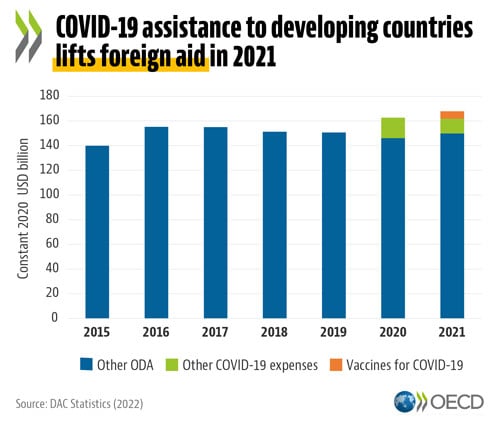12/04/2022 – Foreign aid from official donors rose to an all-time high of USD 179 billion in 2021, up 4.4% in real terms from 2020 as developed countries stepped up their help for developing countries grappling with the COVID-19 crisis, according to preliminary data collected by the OECD.
 Official Development Assistance (ODA) provided by members of the OECD’s Development Assistance Committee (DAC) in 2021 included USD 6.3 billion spent on providing COVID-19 vaccines to developing countries, equivalent to 3.5% of total ODA. Excluding ODA for donated COVID-19 vaccines, ODA was up 0.6% in real terms from 2020.
Official Development Assistance (ODA) provided by members of the OECD’s Development Assistance Committee (DAC) in 2021 included USD 6.3 billion spent on providing COVID-19 vaccines to developing countries, equivalent to 3.5% of total ODA. Excluding ODA for donated COVID-19 vaccines, ODA was up 0.6% in real terms from 2020.
ODA for donated COVID-19 vaccines equated to nearly 857 million doses for developing countries. Within the USD 6.3 billion total, USD 2.3 billion (1.3% of total ODA), covered donated doses left over from domestic supplies (nearly 357 million doses), USD 3.5 billion went on doses purchased specifically for developing countries, and USD 0.5 billion went on secondary costs. All but one of the DAC’s donors followed an OECD recommendation to value 2021 donations of excess COVID-19 vaccines at USD 6.72 per dose, and to make any necessary adjustments if they paid less to ensure no overstating of ODA. (See on valuing 2021 donations of excess vaccines and .)
DAC donors spent a total of USD 18.7 billion on COVID-19 related activities, accounting for 10.5% of their combined net 2021 ODA – up from USD 16.6 billion or 10.2% of total ODA in 2020.
“OECD countries have once again shown that even in times of crisis they will step up and provide support to more vulnerable countries and people,” OECD Secretary-General Mathias Cormann said, presenting the new data. “While the effort last year was another significant step up in development support, there continues to be much more to be done. With the world now hit by a new humanitarian crisis following Russia’s unprovoked war on Ukraine, we must make additional efforts to help those developing countries that will be hardest hit by supply shortages and higher prices for food and key commodities.”
The 2021 ODA total is equivalent to 0.33% of DAC donors’ combined gross national income (GNI), unchanged from 2020 and still below the UN target of 0.7% ODA to GNI. Fluctuations in countries’ GNI levels due to the COVID-19 crisis will have affected the trend in that ratio since 2020. Five DAC members – Denmark, Germany, Luxembourg, Norway and Sweden – met or exceeded the 0.7% target in 2021.
ODA rose in 23 DAC countries in 2021, in many cases due to additional support for developing countries hit by the COVID-19 crisis. It fell in six countries. The largest increases were delivered by Italy (34.5%), Korea (+20.7%), Slovenia (+19.0%), Ireland (+14.8%), the United States (+14.4%), New Zealand (+13.8%), Spain (+12.5%), Japan (+12.1%) and Iceland (+11.7%).
“At the beginning of the pandemic DAC members committed to strive to protect ODA. They continue to live up to this commitment, despite facing tough fiscal and economic pressures, now made much worse by the war in Ukraine,” DAC Chair Susanna Moorehead said. “Multiple crises mean multiple demands on ODA. ODA must support people in need in all partner countries – those forced to flee because of conflict, those who are hungry and those who are particularly poor and vulnerable, especially women and children who suffer most.”
Humanitarian aid amounted to USD 18.8 billion in 2021, up by 3.5% in real terms compared to 2020. Debt relief remained low at USD 545 million. ODA spent on refugees hosted in donor countries were USD 9.3 billion in 2021, little changed in real terms from 2020 and representing 5.2% of total ODA. ODA spent on these so-called in-donor refugee costs has nearly halved (in real terms) since it peaked at USD 16 billion in 2016, when it accounted for 11.0% of total ODA.
The share of loans and equity investments in gross bilateral ODA from DAC members decreased to 19% in 2021 from 21% in 2020, with the rest provided as grants. The decrease came as bilateral sovereign loans by DAC countries fell by 4.6%, on a grant-equivalent basis, after increasing by 35% in real terms between 2018 and 2020. The countries with the highest share of loans in their bilateral ODA were Japan (55%), Korea (36%) and France (23%).
ODA makes up over two thirds of external finance for least-developed countries. The OECD also monitors flows from some non-DAC providers and private foundations. Preliminary data released by the OECD each April is followed by final statistics published around the end of the year with a detailed geographic and sectoral breakdown. (See the 2020 ODA breakdown under Development at .)
Net ODA has risen for the most part steadily in volume terms from just below USD 40 billion (in 2020 prices) in 1960, the first year ODA was measured. It has more than doubled in real terms (up 118%) since 2000, when the Millennium Development Goals were agreed, despite the impact of the 2008 crisis on provider economies. Net ODA has risen by 20% since the SDGs were adopted in 2015.
Links to aid data and background information:
- in detail
- Interactive charts showing







